Firefly
The Lampyridae are a family of insects in the beetle order Coleoptera with more than 2,000 described species. They are soft-bodied beetles that are commonly called fireflies, glowworms, or lightning bugs for their conspicuous use of bioluminescence during twilight to attract mates or prey. Fireflies produce a "cold light", with no infrared or ultraviolet frequencies. This chemically produced light from the lower abdomen may be yellow, green, or pale red, with wavelengths from 510 to 670 nanometers.[4] Some species such as the dimly glowing "blue ghost" of the Eastern U.S. are commonly thought to emit blue light (<490 nanometers), although this is a false perception of their truly green emission light, due to the Purkinje effect.[5]
| Firefly | |
|---|---|
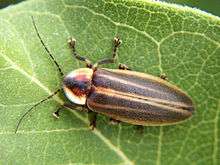 | |
| Photuris lucicrescens[1] | |
_mating.gif) | |
| Male and female of the species Lampyris noctiluca mating | |
| Scientific classification | |
| Kingdom: | Animalia |
| Phylum: | Arthropoda |
| Class: | Insecta |
| Order: | Coleoptera |
| Suborder: | Polyphaga |
| Infraorder: | Elateriformia |
| Superfamily: | Elateroidea |
| Family: | Lampyridae Latreille, 1817 |
| Subfamilies | |
|
Amydetinae[2] Genera incertae sedis[2]: | |
Fireflies are found in temperate and tropical climates. Many are found in marshes or in wet, wooded areas where their larvae have abundant sources of food. Some species are called "glowworms" in Eurasia and elsewhere. While all known fireflies glow, only some adults produce light and the location of the light organ varies among species and between sexes of the same species. The form of the insect that emits light varies from species to species (for example, in the glow worm found in the UK, Lampyris noctiluca, it is the female that is most easily noticed.[6][7]). In the Americas, "glow worm" also refers to the closely related family Phengodidae. In New Zealand and Australia the term "glow worm" is in use for the luminescent larvae of the fungus gnat Arachnocampa.[8] In some species of firefly, the females are flightless.[9]
Biology
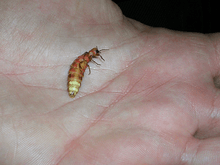
Fireflies have a large amount of variation in their general appearance, with differences in color, shape, size, and features such as antennae. Adults can differ drastically in size depending on the species, with the largest being up to an inch long. Although the females of some species are similar in appearance to males, larviform females are found in many firefly species. These females can often be distinguished from the larvae only because the adults have compound eyes, although the latter are much smaller than those of their males and often highly regressed.[10] The most commonly known fireflies are nocturnal,[11] although numerous species are diurnal. Most diurnal species are not luminescent; however, some species that remain in shadowy areas may produce light.
Fireflies undergo a transformation called complete metamorphosis.[12]
A few days after mating, a female lays her fertilized eggs on or just below the surface of the ground. The eggs hatch three to four weeks later, and the larvae feed until the end of the summer. The larvae are commonly called glowworms (not to be confused with the distinct beetle family Phengodidae or the fly genus Arachnocampa). Lampyrid larvae have simple eyes. The term glowworm is also used for both adults and larvae of species such as Lampyris noctiluca, the common European glowworm, in which only the nonflying adult females glow brightly and the flying males glow only weakly and intermittently.
Fireflies hibernate over winter during the larval stage, some species for several years. Some do this by burrowing underground, while others find places on or under the bark of trees. They emerge in the spring. After several weeks of feeding on other insects, snails, and worms, they pupate for 1.0 to 2.5 weeks and emerge as adults. The larvae of most species are specialized predators and feed on other larvae, terrestrial snails, and slugs. Some are so specialized that they have grooved mandibles that deliver digestive fluids directly to their prey. Adult diet varies: some are predatory, while others feed on plant pollen or nectar. Some, like the European glow-worm beetle, Lampyris noctiluca, have no mouth.
Most fireflies are distasteful to many vertebrate predators. This is due at least in part to a group of steroid pyrones known as lucibufagins, which are similar to cardiotonic bufadienolides found in some poisonous toads.[13]
Light and chemical production
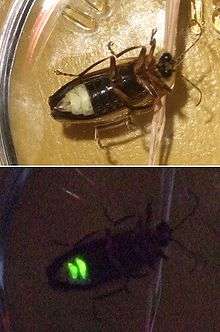
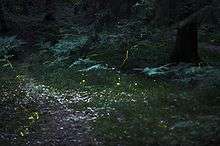
Light production in fireflies is due to a type of chemical reaction called bioluminescence. This process occurs in specialized light-emitting organs, usually on a firefly's lower abdomen. The enzyme luciferase acts on the luciferin, in the presence of magnesium ions, ATP, and oxygen to produce light. Gene coding for these substances has been inserted into many different organisms (see Luciferase – Applications). The genetics of firefly bioluminescence, focusing on luciferase, has been reviewed by John Day.[14] Firefly luciferase is used in forensics, and the enzyme has medical uses – in particular, for detecting the presence of ATP or magnesium. All fireflies glow as larvae. In lampyrid larvae, bioluminescence serves a function that is different from that served in adults. It appears to be a warning signal to predators, since many firefly larvae contain chemicals that are distasteful or toxic.[15][16]
Photic emission in the adult beetle was originally thought to be used for similar warning purposes, but it is now understood that its primary purpose is in mate selection. It has been shown that early larval bioluminescence was adopted in adult fireflies, and was repeatedly gained and lost before becoming fixed and retained as a mechanism of sexual communication in many species.[15][17] Adult lampyrids have a variety of ways to communicate with mates in courtships: steady glows, flashing, and the use of chemical signals unrelated to photic systems.[18] Chemical signals, or pheromones, are the ancestral form of sexual communication; this pre-dates the evolution of flash signaling in the lineage, and is retained today in diurnally-active species.[15][19] Signals, whether photic or chemical, allow fireflies to identify mates of their own species. Flash signaling characteristics include differences in duration, timing, color, and repetition, and vary interspecifically and geographically.[20] When flash signals are not sufficiently distinguished between species in a population, sexual selection encourages divergence of signaling patterns.[20]
Some species, especially lightning bugs of the genera Photinus, Photuris, and Pyractomena, are distinguished by the unique courtship flash patterns emitted by flying males in search of females. In general, females of the genus Photinus do not fly, but do give a flash response to males of their own species.

Synchronization of flashing is a phenomenon of several firefly species. This phenomenon is explained as phase synchronization and spontaneous order.[21] Tropical fireflies routinely synchronise their flashes among large groups, particularly in Southeast Asia. At night along river banks in the Malaysian jungles, fireflies synchronize their light emissions precisely. Current hypotheses about the causes of this behavior involve diet, social interaction, and altitude. In the Philippines, thousands of fireflies can be seen all year-round in the town of Donsol (called aninipot or totonbalagon in Bicol). In the United States, one of the most famous sightings of fireflies blinking in unison occurs annually near Elkmont, Tennessee, in the Great Smoky Mountains during the first weeks of June.[22] Congaree National Park in South Carolina is another host to this phenomenon.[23]
Female Photuris fireflies are known for mimicking the photic signaling patterns of other fireflies for the sole purpose of predation; they often prey upon smaller Photinus fireflies.[15] Target males are attracted to what appears to be a suitable mate, and are then eaten. For this reason, Photuris species are sometimes referred to as "femme fatale fireflies".
Many fireflies do not produce light. Usually these species are diurnal, or day-flying, such as those in the genus Ellychnia. A few diurnal fireflies that inhabit primarily shadowy places, such as beneath tall plants or trees, are luminescent. One such genus is Lucidota. Non-bioluminescent fireflies use pheromones to signal mates. This is supported by the fact that some basal groups do not show bioluminescence and use chemical signaling, instead. Phosphaenus hemipterus has photic organs, yet is a diurnal firefly and displays large antennae and small eyes. These traits strongly suggest pheromones are used for sexual selection, while photic organs are used for warning signals. In controlled experiments, males coming from downwind arrived at females first, indicating males travel upwind along a pheromone plume. Males were also found to be able to find females without the use of visual cues, when the sides of test Petri dishes were covered with black tape. This and the facts that females do not light up at night and males are diurnal point to the conclusion that sexual communication in P. hemipterus is based entirely on pheromones.[24]
Systematics
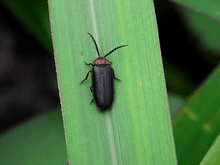
Firefly systematics, as with many insects, are in a constant state of flux, as new species continue to be discovered. The five subfamilies listed above are the most commonly accepted ones, though others, such as the Amydetinae and Psilocladinae, have been proposed. This was mainly done in an attempt to revise the Lampyrinae, which bit by bit had become something of a "wastebin taxon" to hold incertae sedis species and genera of fireflies. Other changes have been proposed, such as merging the Ototretinae into the Luciolinae, but the arrangement used here appears to be the most frequently seen and stable layout for the time being. Though most groups appear to be monophyletic, some (e.g., the tribe Photinini) are perhaps better divided.
Two groups of subfamilies seem to exist: one containing many American and some Eurasian species in the Lampyrinae and Photurinae; and one, predominantly Asian, made up from the other subfamilies. While the subfamilies as understood here are, in general, monophyletic, a few genera still need to be moved for the subfamilies to accurately represent the evolutionary relationships among the fireflies.
The Rhagophthalmidae are a glow-worm-like lineage of Elateroidea. They have in the recent past usually been considered a distinct family, but whether this is correct is still disputed. Indeed, they might be the only close relative of the puzzling firefly genus Pterotus, which sometimes is placed in a monotypic subfamily.
The genus Phausis, usually placed in the tribe Photinini of the Lampyrinae, might represent another rather distinct lineage instead.
Conservation
Firefly populations are declining worldwide, for a variety of reasons.[25] Fireflies, like many other organisms, are directly affected by land-use change (e.g. loss of habitat area and connectivity), which is identified as the main driver of biodiversity changes in terrestrial ecosystems.[26] Pesticides and weed-killers have also been indicated as a likely cause of firefly decline.[27]
Finally, since fireflies depend on their own light to reproduce [28] they are also very sensitive to environmental levels of light and consequently to light pollution.[28][29] Multiple recent studies investigate deeply the effects of artificial night lighting on fireflies.[30][31]
Fireflies are charismatic (which is a rare quality amongst insects) and are easily spotted by non-experts, providing thus good flagship species to attract public attention; good investigation models for the effects of light on nocturnal wildlife; and finally, due to their sensibility and rapid response to environmental changes, good bioindicators for artificial night lighting.[29]
Phylogeny
Based on Martin et al. 2019[2]
| Lampyridae |
| ||||||||||||||||||||||||||||||||||||||||||
References
- Cirrus Digital Firefly Photuris lucicrescens
- Martin, Gavin J; Stanger-Hall, Kathrin F; Branham, Marc A; Da Silveira, Luiz F L; Lower, Sarah E; Hall, David W; Li, Xue-Yan; Lemmon, Alan R; Moriarty Lemmon, Emily; Bybee, Seth M (1 November 2019). Jordal, Bjarte (ed.). "Higher-Level Phylogeny and Reclassification of Lampyridae (Coleoptera: Elateroidea)". Insect Systematics and Diversity. Oxford University Press (OUP). 3 (6). doi:10.1093/isd/ixz024. ISSN 2399-3421.
- Ferreira, Vinicius S; Keller, Oliver; Branham, Marc A; Ivie, Michael A (2019). "Molecular data support the placement of the enigmatic Cheguevaria as a subfamily of Lampyridae (Insecta: Coleoptera)". Zoological Journal of the Linnean Society. Oxford University Press (OUP). 187 (4): 1253–1258. doi:10.1093/zoolinnean/zlz073. ISSN 0024-4082.
- HowStuffWorks "How do fireflies light up?". Science.howstuffworks.com (19 January 2001). Retrieved on 22 June 2013.
- Branchini, Bruce R.; Southworth, Tara L.; Salituro, Leah J.; Fontaine, Danielle M.; Oba, Yuichi (2017). "Cloning of the Blue Ghost (Phausis reticulata) Luciferase Reveals a Glowing Source of Green Light". Photochemistry and Photobiology. 93 (2): 473–478. doi:10.1111/php.12649. PMID 27696431.
- "UK Glow worm survey home page".
- "Enter a glow-worm record". 11 June 2015. Retrieved 19 July 2018.
- Meyer-Rochow, Victor Benno (2007). "Glowworms: a review of "Arachnocampa" spp and kin". Luminescence. 22 (3): 251–265. doi:10.1002/bio.955. PMID 17285566.
- In Fireflies, Flightless Females Lose out On Gifts from Males. Science Daily (27 June 2011). Retrieved on 22 June 2013.
- Lau, T.F.; Meyer-Rochow, V.B. (2006). "Sexual dimorphism in the compound eye of Rhagophthalmus ohbai (Coleoptera: Rhagophthalmidae): Morphology and ultrastructure". Journal of Asia-Pacific Entomology. 9: 19–30. doi:10.1016/S1226-8615(08)60271-X.
- "Firefly". TheFreeDictionary.com. Retrieved 22 June 2013.
- Lewis, Sara (26 April 2016). A book titled: Silent Sparks: The Wondrous World of Fireflies. ISBN 9781400880317.
- Eisner, Thomas; Wiemer, David; Haynes, Leroy; Meinwald, Jerrold (1978). "Lucibufagins: Defensive steroids from the fireflies Photinus ignitus and P. marginellus (Coleoptera: Lampyridae)". Proceedings of the National Academy of Sciences of the United States of America. 75 (2): 905–908. Bibcode:1978PNAS...75..905E. doi:10.1073/pnas.75.2.905. PMC 411366. PMID 16592501.
- Day, John (2009). "Beetle bioluminescence: a genetic and enzymatic research review". In Meyer-Rochow, V.B. (ed.). Bioluminescence in Focus. Research Signpost: Kerala. pp. 325–355.
- Lewis, Sara M.; Cratsley, Christopher K. (January 2008). "Flash Signal Evolution, Mate Choice, and Predation in Fireflies". Annual Review of Entomology. 53 (1): 293–321. doi:10.1146/annurev.ento.53.103106.093346. ISSN 0066-4170. PMID 17877452. S2CID 16360536.
- Branham, Marc A.; Wenzel, John W. (December 2001). "The Evolution of Bioluminescence in Cantharoids (Coleoptera: Elateroidea)". The Florida Entomologist. 84 (4): 565. doi:10.2307/3496389. ISSN 0015-4040. JSTOR 3496389.
- Martin, Gavin J.; Branham, Marc A.; Whiting, Michael F.; Bybee, Seth M. (February 2017). "Total evidence phylogeny and the evolution of adult bioluminescence in fireflies (Coleoptera: Lampyridae)". Molecular Phylogenetics and Evolution. 107: 564–575. doi:10.1016/j.ympev.2016.12.017. ISSN 1055-7903. PMID 27998815.
- Stanger-Hall, K.F.; Lloyd, J.E.; Hillis, D.M. (2007). "Phylogeny of North American fireflies (Coleoptera: Lampyridae): implications for the evolution of light signals". Molecular Phylogenetics and Evolution. 45 (1): 33–49. doi:10.1016/j.ympev.2007.05.013. PMID 17644427.
- Branham, M (February 2003). "The origin of photic behavior and the evolution of sexual communication in fireflies (Coleoptera: Lampyridae)". Cladistics. 19 (1): 1–22. doi:10.1111/j.1096-0031.2003.tb00404.x. ISSN 0748-3007.
- Stanger-Hall, Kathrin F.; Lloyd, James E. (March 2015). "Flash signal evolution inPhotinusfireflies: Character displacement and signal exploitation in a visual communication system". Evolution. 69 (3): 666–682. doi:10.1111/evo.12606. ISSN 0014-3820. PMID 25627920.
- Murray, James D. (2002). Mathematical Biology. I. An Introduction (3rd ed.). Springer. pp. 295–299. ISBN 978-0-387-95223-9.
- Synchronous Fireflies – Great Smoky Mountains National Park. Nps.gov (3 June 2013). Retrieved on 22 June 2013.
- Cross, Robert (23 May 2004) Tree huggin'. Chicago Tribune.
- De Cock, R.; Matthysen, E. (2005). "Sexual communication by pheromones in a firefly, Phosphaenus hemipterus (Coleoptera: Lampyridae)". Animal Behaviour. 70 (4): 807–818. doi:10.1016/j.anbehav.2005.01.011.
- Firefly.org
- Sala, Osvaldo E.; Chapin, F. Stuart; Iii; Armesto, Juan J.; Berlow, Eric; Bloomfield, Janine; Dirzo, Rodolfo; Huber-Sanwald, Elisabeth; Huenneke, Laura F. (10 March 2000). "Global Biodiversity Scenarios for the Year 2100". Science. 287 (5459): 1770–1774. doi:10.1126/science.287.5459.1770. ISSN 0036-8075. PMID 10710299.
- See "How You Can Help", FireFly.org, citing (1) "Understanding Halofenozide (Mach 2) and Imidacloprid (Merit) Soil Insecticides," by Daniel A Potter. International SportsTurf Institute, Inc., Turfax, Vol. 6 No. 1 (Jan-Feb 1998) and (2) "Relative Toxicities of Chemicals to the Earthworm Eisenia foetida," by Brian L. Roberts and H. Wyman Dorough. Article first published online: 20 Oct 2009. Environmental Toxicology and Chemistry, Vol. 3, No. 1 (Jan. 1984), pp. 67–78.
- Lloyd, James E.; Wing, Steven R.; Hongtrakul, Tawatchai (1989). "Ecology, Flashes, and Behavior of Congregating Thai Fireflies". Biotropica. 21 (4): 373. doi:10.2307/2388290. JSTOR 2388290.
- Viviani, Vadim Ravara; Rocha, Mayra Yamazaki; Hagen, Oskar (June 2010). "Fauna de besouros bioluminescentes (Coleoptera: Elateroidea: Lampyridae; Phengodidae, Elateridae) nos municípios de Campinas, Sorocaba-Votorantim e Rio Claro-Limeira (SP, Brasil): biodiversidade e influência da urbanização". Biota Neotropica. 10 (2): 103–116. doi:10.1590/s1676-06032010000200013. ISSN 1676-0603.
- Firebaugh, Ariel; Haynes, Kyle J. (1 December 2016). "Experimental tests of light-pollution impacts on nocturnal insect courtship and dispersal". Oecologia. 182 (4): 1203–1211. Bibcode:2016Oecol.182.1203F. doi:10.1007/s00442-016-3723-1. ISSN 0029-8549. PMID 27646716.
- Owens, Avalon Celeste Stevahn; Meyer-Rochow, Victor Benno; Yang, En-Cheng (7 February 2018). "Short- and mid-wavelength artificial light influences the flash signals of Aquatica ficta fireflies (Coleoptera: Lampyridae)". PLOS ONE. 13 (2): e0191576. Bibcode:2018PLoSO..1391576O. doi:10.1371/journal.pone.0191576. ISSN 1932-6203. PMC 5802884. PMID 29415023.
Further reading
- Branham, M. A.; Wenzel, J. W. (2003). "The origin of photic behavior and the evolution of sexual communication in fireflies (Coleoptera: Lampyridae)". Cladistics. 19 (1): 1–22. doi:10.1111/j.1096-0031.2003.tb00404.x.
- Lewis, S. M.; Cratsley, C. K. (2008). "Flash signal evolution, mate choice, and predation in fireflies". Annual Review of Entomology. 53: 293–321. doi:10.1146/annurev.ento.53.103106.093346. PMID 17877452. S2CID 16360536.
- Stous, Hollend (1997). "A review of predation in Photuris, and its effects on the evolution of flash signaling in other New World fireflies". Cite journal requires
|journal=(help) - Faust, Lynn Frierson (2017). "Fireflies, Glow-worms, and Lightning Bugs"
- "Understanding Halofenozide (Mach 2) and Imidacloprid (Merit) Soil Insecticides," by Daniel A Potter. International SportsTurf Institute, Inc., Turfax, Vol. 6 No. 1 (Jan-Feb 1998)
- "Relative Toxicities of Chemicals to the Earthworm Eisenia foetida," by Brian L. Roberts and H. Wyman Dorough. Article first published online: 20 Oct 2009. Environmental Toxicology and Chemistry, Vol. 3, No. 1 (Jan. 1984), pp. 67–78.<
External links
| Wikiquote has quotations related to: Fireflies |
| Look up firefly in Wiktionary, the free dictionary. |
| Wikimedia Commons has media related to Lampyridae. |
- An introduction to European fireflies and glow-worms
- Firefly.org – Firefly & Lightning Bug Facts, Pictures, Information About Firefly Insect Disappearance
- Firefly simulating robot, China
- NCBI taxonomy database
- Museum of Science, Boston – Understanding Fireflies
- Video of a firefly larva in Austria
- FireflyExperience.org – Luminous Photography and Videos of Fireflies & Lightning Bugs